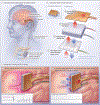Focal Cooling for Drug-Resistant Epilepsy: A Review
- PMID: 35877102
- PMCID: PMC10101767
- DOI: 10.1001/jamaneurol.2022.1936
Focal Cooling for Drug-Resistant Epilepsy: A Review
Abstract
Importance: Epilepsy affects at least 1.2% of the population, with one-third of cases considered to be drug-resistant epilepsy (DRE). For these cases, focal cooling therapy may be a potential avenue for treatment, offering hope to people with DRE for freedom from seizure. The therapy leverages neuroscience and engineering principles to deliver a reversible treatment unhindered by pharmacology.
Observations: Analogous to (but safer than) the use of global cooling in postcardiac arrest and neonatal ischemic injury, extensive research supports the premise that focal cooling as a long-term treatment for epilepsy could be effective. The potential advantages of focal cooling are trifold: stopping epileptiform discharges, seizures, and status epilepticus safely across species (including humans).
Conclusions and relevance: This Review presents the most current evidence supporting focal cooling in epilepsy. Cooling has been demonstrated as a potentially safe and effective treatment modality for DRE, although it is not yet ready for use in humans outside of randomized clinical trials. The Review will also offer a brief overview of the technical challenges related to focal cooling in humans, including the optimal device design and cooling parameters.
Figures
Similar articles
-
Rufinamide add-on therapy for drug-resistant epilepsy.Cochrane Database Syst Rev. 2020 Nov 8;11(11):CD011772. doi: 10.1002/14651858.CD011772.pub3. Cochrane Database Syst Rev. 2020. PMID: 33179247 Free PMC article.
-
The burden of chronic drug-refractory focal onset epilepsy: Can it be prevented?Epilepsy Behav. 2023 Nov;148:109435. doi: 10.1016/j.yebeh.2023.109435. Epub 2023 Sep 23. Epilepsy Behav. 2023. PMID: 37748414 Review.
-
Electro-clinical analysis of epilepsy patients with generalized seizures on adjunctive perampanel treatment.Epilepsy Res. 2020 Sep;165:106378. doi: 10.1016/j.eplepsyres.2020.106378. Epub 2020 May 31. Epilepsy Res. 2020. PMID: 32622260
-
Number needed to treat and associated cost analysis of cenobamate versus third-generation anti-seizure medications for the treatment of focal-onset seizures in patients with drug-resistant epilepsy in Spain.Epilepsy Behav. 2023 Feb;139:109054. doi: 10.1016/j.yebeh.2022.109054. Epub 2023 Jan 3. Epilepsy Behav. 2023. PMID: 36603345
-
Carbamazepine versus phenytoin monotherapy for epilepsy: an individual participant data review.Cochrane Database Syst Rev. 2019 Jul 18;7(7):CD001911. doi: 10.1002/14651858.CD001911.pub4. Cochrane Database Syst Rev. 2019. PMID: 31318037 Free PMC article.
Cited by
-
The efficacy and safety of third-generation antiseizure medications and non-invasive brain stimulation to treat refractory epilepsy: a systematic review and network meta-analysis study.Front Neurol. 2024 Jan 9;14:1307296. doi: 10.3389/fneur.2023.1307296. eCollection 2023. Front Neurol. 2024. PMID: 38264091 Free PMC article.



